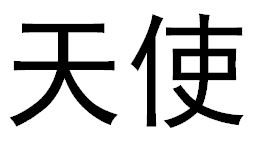 When I was working for Silver State Helicopters, there was a young woman working as the administrative assistant for the IT department named Kristin. Kristin had (and presumably still has) a tattoo on the back of her neck of two kanji. She requested the kanji because the shop told her they meant “angel.”
When I was working for Silver State Helicopters, there was a young woman working as the administrative assistant for the IT department named Kristin. Kristin had (and presumably still has) a tattoo on the back of her neck of two kanji. She requested the kanji because the shop told her they meant “angel.”
Many Americans seem to be fascinated with the idea of getting something ancient tattooed on themselves, adding history and significance by association with indelibly-marked symbols and ideas. Many people get tribal tattoos from tribes they’ve never met (or that never existed), military symbols from armies of which they’ve never been a part, and writing in languages they don’t speak.
The problem with this of course, is that if you’re not actually in the group with which you’re associating yourself, you can’t really be sure of all the baggage that comes with the symbology- or worse, that the symbols you’ve chosen to mark your skin for life mean something wholly different than what your tattoo artist told you they mean.
 Kristin thought she was getting a tattoo of the Japanese kanji for “angel,” and I’m happy to report that she basically got what she paid for. I asked my school’s office manager to look at the photo Kristin kindly let me take of her tattoo, and she said that while the kanji certainly says “angel,” it doesn’t look Japanese, but likely a script form of older Chinese kanji. The modern Japanese print form is on the left.
Kristin thought she was getting a tattoo of the Japanese kanji for “angel,” and I’m happy to report that she basically got what she paid for. I asked my school’s office manager to look at the photo Kristin kindly let me take of her tattoo, and she said that while the kanji certainly says “angel,” it doesn’t look Japanese, but likely a script form of older Chinese kanji. The modern Japanese print form is on the left.
If you’re interested, the first symbol is 天, often pronounced “ten,” and is the symbol for “heaven” and “sky.” It’s also the first part of the word “tempura.” The second symbol is 使, with many different readings, most of which are a derivation of “messenger” or “envoy.” Thus 天使 means “heaven’s messenger,” or “angel.”
Leave a Reply